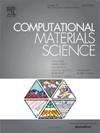Ab initio investigation on intrinsic Ga vacancies in β-Ga2O3 utilizing hybrid functional combined with the shell DFT-1/2 approach
IF 3.1
3区 材料科学
Q2 MATERIALS SCIENCE, MULTIDISCIPLINARY
引用次数: 0
Abstract
The monoclinic crystal system β-gallium oxide (β-Ga2O3) is an advantageous semiconductor, characterized by a substantial bandgap of approximately 4.8 eV, exceptional stability under ambient conditions, and transparency to ultraviolet (UV) light. In practical applications, it is critical to effectively manage defects within β-Ga2O3. Failure to rigorously control defect types and concentrations can significantly compromise device stability and reliability. Among the prevalent and impactful defects, Ga intrinsic vacancies notably affect the optoelectronic performance of β-Ga2O3, yet they have not been comprehensively studied using suitable generalized approximations. This paper systematically examines the electronic and optical properties of β-Ga2O3 with intrinsic Ga vacancies using hybrid functional methods combined with the shell DFT-1/2 approach. Key properties analyzed include electronic bandgap and density of states, structural properties like elastic constants and phonon dispersion, and optoelectronic properties such as permittivity, absorption spectra, and electronic energy-loss spectra. Detailed discussion is provided on the formation energy curves of these Ga intrinsic defects.

求助全文
约1分钟内获得全文
求助全文
来源期刊

Computational Materials Science
工程技术-材料科学:综合
CiteScore
6.50
自引率
6.10%
发文量
665
审稿时长
26 days
期刊介绍:
The goal of Computational Materials Science is to report on results that provide new or unique insights into, or significantly expand our understanding of, the properties of materials or phenomena associated with their design, synthesis, processing, characterization, and utilization. To be relevant to the journal, the results should be applied or applicable to specific material systems that are discussed within the submission.
 求助内容:
求助内容: 应助结果提醒方式:
应助结果提醒方式:


